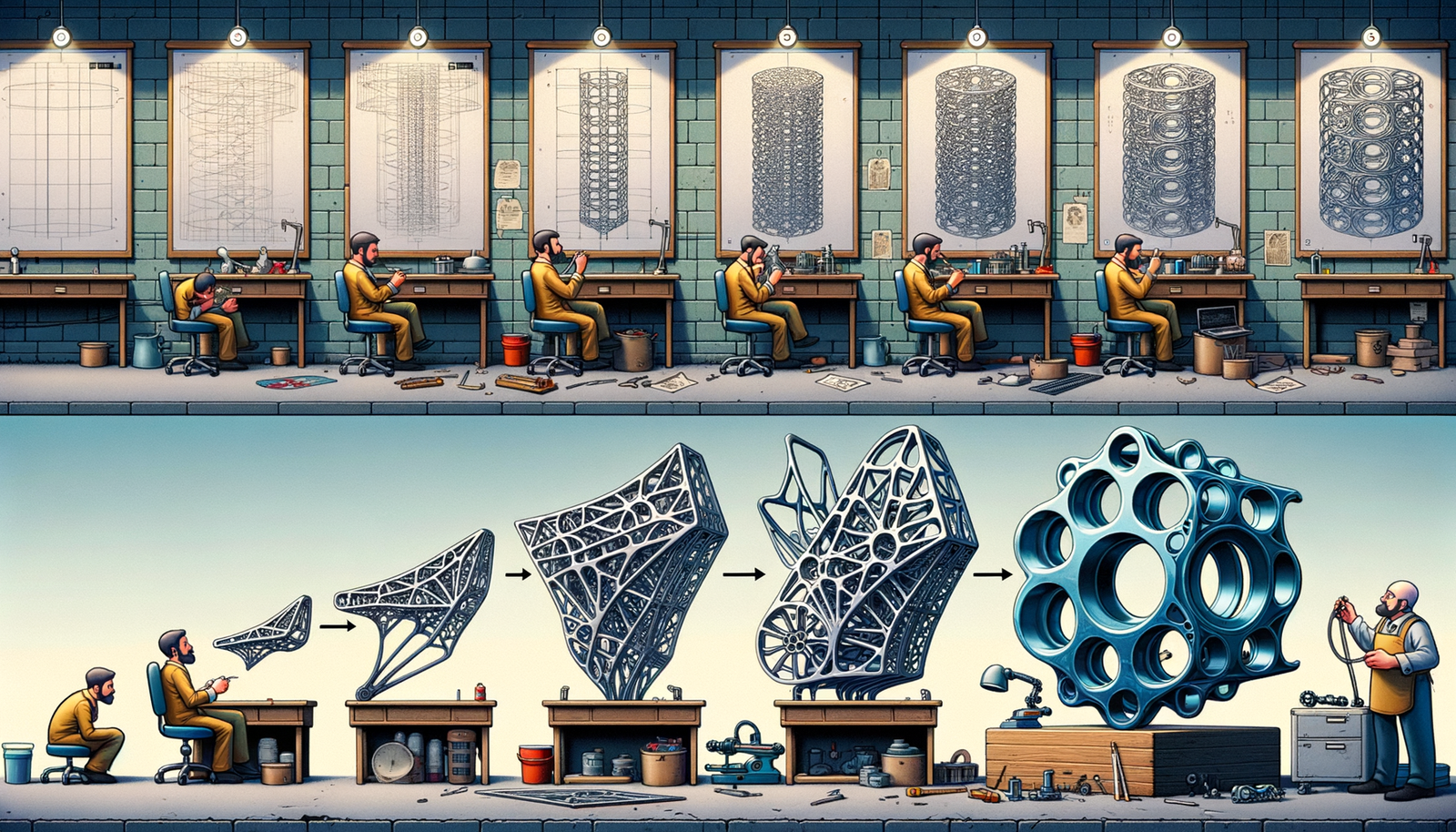Your Cart is Empty
Customer Testimonials
-
"Great customer service. The folks at Novedge were super helpful in navigating a somewhat complicated order including software upgrades and serial numbers in various stages of inactivity. They were friendly and helpful throughout the process.."
Ruben Ruckmark
"Quick & very helpful. We have been using Novedge for years and are very happy with their quick service when we need to make a purchase and excellent support resolving any issues."
Will Woodson
"Scott is the best. He reminds me about subscriptions dates, guides me in the correct direction for updates. He always responds promptly to me. He is literally the reason I continue to work with Novedge and will do so in the future."
Edward Mchugh
"Calvin Lok is “the man”. After my purchase of Sketchup 2021, he called me and provided step-by-step instructions to ease me through difficulties I was having with the setup of my new software."
Mike Borzage
Design Software History: Evolution and Impact of Topology Optimization in Engineering Design
October 15, 2024 6 min read


Introduction
Topology optimization is a revolutionary approach in engineering design that focuses on optimizing material layout within a given design space, for a set of loads and boundary conditions, such that the resulting structure meets the desired performance targets. This method has significantly transformed how engineers and designers conceptualize and develop products, pushing the boundaries of innovation and efficiency. Over the years, topology optimization has evolved from a theoretical concept into a practical tool, thanks to advancements in computational algorithms and design software. Its impact spans across various engineering disciplines, leading to the creation of lighter, stronger, and more efficient structures. Key technologies and algorithms, such as finite element analysis and gradient-based optimization methods, have been instrumental in facilitating topology optimization, making it an indispensable part of modern engineering design processes.
Historical Context and Development
The foundations of optimization techniques date back to the mid-20th century with the advent of mathematical programming methods. One of the pioneers in this field was George Dantzig, who developed the Simplex Method for linear programming in 1947. His work laid the groundwork for solving optimization problems by finding the best outcome in a mathematical model whose requirements are represented by linear relationships. As industries began to recognize the potential of these mathematical approaches, there was a gradual transition from traditional, trial-and-error design methods to more systematic, mathematically driven optimization techniques. This shift was further propelled by the need for more efficient and cost-effective designs in competitive markets.
The emergence of topology optimization in the 1980s marked a significant milestone in the field of structural optimization. Key figures such as Martin Philip Bendsoe and Ole Sigmund made substantial contributions to the development of this discipline. Bendsoe's seminal work, often in collaboration with Sigmund, introduced the concept of distributing material within a design space to achieve optimal structural performance. Their research focused on developing mathematical models and numerical methods that could handle complex optimization problems involving material distribution. The homogenization method and the solid isotropic material with penalization (SIMP) technique are among the notable theories they developed, which have become fundamental in topology optimization algorithms. These methodologies allowed engineers to optimize structures at a granular level, considering not just the shape but the material distribution within the design space.
Core Technologies and Mathematical Models
At the heart of topology optimization lies a robust mathematical framework that relies heavily on finite element analysis (FEA). FEA is a computational technique used to approximate solutions to complex structural analysis problems. In topology optimization, FEA is employed to evaluate the performance of different design iterations under specified loads and boundary conditions. The process involves discretizing the design space into finite elements and iteratively adjusting the material properties of each element to minimize or maximize a given objective function, such as stiffness or weight.
The governing equations used in structural optimization are derived from principles of mechanics and material science. They include equilibrium equations, compatibility conditions, and constitutive relationships that define how materials deform under loads. Optimization algorithms utilize these equations to compute sensitivity information, which indicates how small changes in design variables affect the objective function. This information is crucial for gradient-based optimization methods, which are commonly used in topology optimization due to their efficiency in handling large-scale problems.
Advancements in computational power and CAD software integration have been pivotal in making topology optimization a practical tool for engineers. Modern CAD platforms incorporate optimization modules that allow seamless transition from optimization results to detailed design models. This integration simplifies the workflow, enabling designers to rapidly iterate and refine their designs. The increase in computational resources has also enabled the implementation of real-time optimization processes, where engineers can observe the evolution of the design in response to applied loads and constraints, greatly enhancing the design exploration phase.
Applications Across Industries
Topology optimization has found widespread applications across various industries due to its ability to produce innovative designs that are both efficient and cost-effective. In the aerospace industry, companies like Boeing and Airbus utilize topology optimization to develop lightweight structures that enhance aircraft performance. By reducing the weight of components such as brackets, ribs, and bulkheads, aircraft can achieve lower fuel consumption and increased payload capacity. The rigorous demands of aerospace engineering, where strength-to-weight ratio is critical, make topology optimization an invaluable tool.
In the automotive sector, manufacturers employ topology optimization to design components that improve fuel efficiency and safety. The reduction of vehicle weight is directly correlated to better fuel economy and lower emissions. Engineers use optimization techniques to redesign chassis components, suspension systems, and engine parts, ensuring they meet performance requirements while minimizing material usage. Additionally, by optimizing energy absorption characteristics, safety features such as crumple zones can be enhanced to provide better protection during collisions.
The biomedical field also benefits significantly from topology optimization. Designing implants and prosthetics that must conform to complex anatomical structures requires sophisticated optimization methods. Engineers develop customized orthopedic implants and dental prosthetics that offer optimal performance and compatibility with the human body. By tailoring the internal architecture of these devices, it is possible to achieve desired mechanical properties, such as stiffness and strength, while ensuring biocompatibility and patient comfort.
Future Trends and Challenges
Current trends in topology optimization are focused on integrating the technology with additive manufacturing, also known as 3D printing. This integration allows for the fabrication of complex geometries that were previously impossible with traditional manufacturing methods. Additive manufacturing enables the production of intricate internal lattice structures and organic shapes optimized for specific performance criteria. The synergy between topology optimization and additive manufacturing is paving the way for unprecedented levels of customization and efficiency in product design.
Another emerging trend is the incorporation of artificial intelligence (AI) and machine learning into the optimization process. AI algorithms can enhance design iterations by learning from previous optimization results and predicting optimal configurations more quickly. Machine learning models can identify patterns and relationships within large datasets of design variables and performance outcomes, leading to more intelligent and efficient optimization strategies. This approach has the potential to significantly reduce computation times and expand the scope of problems that can be addressed.
Despite these advancements, there are several challenges facing the widespread adoption of topology optimization. One major hurdle is the complexity of the software and the need for specialized skills to effectively utilize optimization tools. Engineers must have a deep understanding of both the theoretical and practical aspects of the technology to achieve meaningful results. Additionally, there is often resistance within industries due to traditional design mindsets and reluctance to adopt new methodologies. Overcoming these challenges requires comprehensive training programs and a shift in organizational culture to embrace innovative design practices.
Another challenge is the need to ensure that optimized designs are manufacturable and meet all regulatory and quality standards. While topology optimization can produce highly efficient designs, translating these designs into physical products can be difficult due to manufacturing constraints. Engineers must consider factors such as material properties, fabrication processes, and tolerances when developing optimized designs. This consideration often necessitates a balance between optimal performance and practical manufacturability.
Conclusion
Topology optimization has undeniably transformed engineering design by introducing a methodical and efficient approach to developing high-performance structures. Its ability to optimize material distribution within a design space has led to innovations across various industries, resulting in products that are lighter, stronger, and more efficient than ever before. The integration of advanced computational techniques and the adoption of this technology signify a shift towards more intelligent and sustainable design practices.
Looking forward, the continued development of topology optimization holds great promise for the future of engineering. As computational tools become more powerful and accessible, and as industries become more receptive to innovative design methodologies, topology optimization is poised to play an even more significant role. The integration with additive manufacturing and AI technologies will further enhance its capabilities, leading to new possibilities in product development and customization.
To fully realize the potential of topology optimization, it is essential to address the existing challenges. This includes investing in education and training to develop the necessary expertise, encouraging a culture of innovation within organizations, and collaborating across disciplines to overcome manufacturing constraints. By doing so, engineers and designers can harness the full power of topology optimization, driving forward the boundaries of what is possible in engineering design and contributing to advancements across numerous fields.
Also in Design News

2D/3D Animation:Collaboratory with Mike Morris and Aaron Paetz
February 20, 2025 1 min read
Read More
ZBrush Tip: Enhancing Organic Sculpting Techniques in ZBrush: Key Tips and Resources
February 20, 2025 2 min read
Read More
Revit Tip: Mastering Revit's Edit Profile Tool for Customized Design Efficiency
February 20, 2025 2 min read
Read MoreSubscribe
Sign up to get the latest on sales, new releases and more …


